2015 CHEVROLET CITY EXPRESS check engine
[x] Cancel search: check enginePage 203 of 297
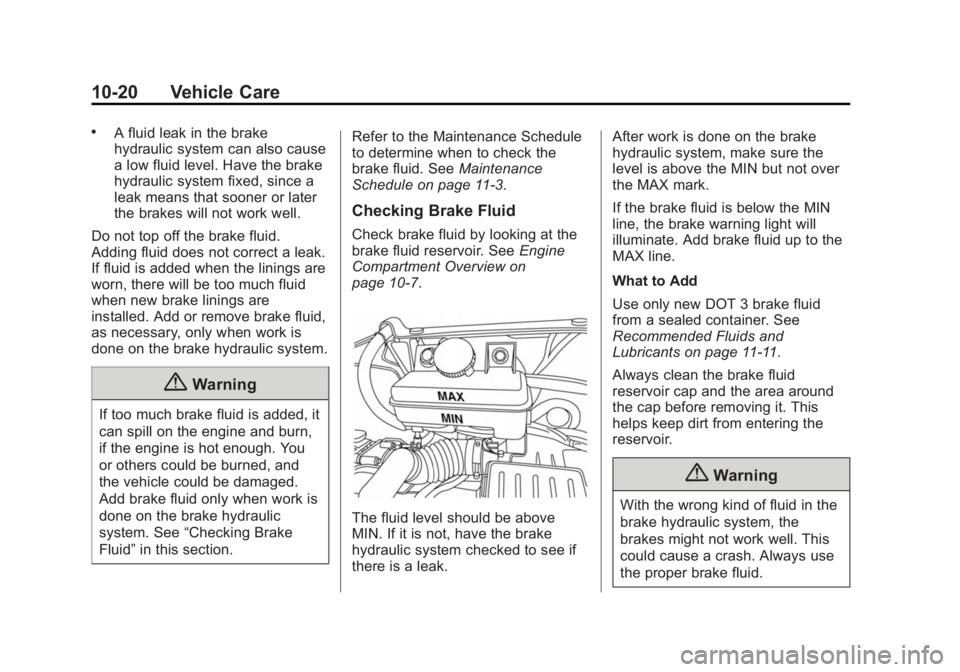
Black plate (20,1)Chevrolet City Express Owner Manual (GMNA-Localizing-U.S./Canada-
7707496) - 2015 - CRC - 11/26/14
10-20 Vehicle Care .
A fluid leak in the brake
hydraulic system can also cause
a low fluid level. Have the brake
hydraulic system fixed, since a
leak means that sooner or later
the brakes will not work well.
Do not top off the brake fluid.
Adding fluid does not correct a leak.
If fluid is added when the linings are
worn, there will be too much fluid
when new brake linings are
installed. Add or remove brake fluid,
as necessary, only when work is
done on the brake hydraulic system.
{ Warning
If too much brake fluid is added, it
can spill on the engine and burn,
if the engine is hot enough. You
or others could be burned, and
the vehicle could be damaged.
Add brake fluid only when work is
done on the brake hydraulic
system. See “ Checking Brake
Fluid ” in this section. Refer to the Maintenance Schedule
to determine when to check the
brake fluid. See Maintenance
Schedule on page 11-3 .
Checking Brake Fluid Check brake fluid by looking at the
brake fluid reservoir. See Engine
Compartment Overview on
page 10-7 .
The fluid level should be above
MIN. If it is not, have the brake
hydraulic system checked to see if
there is a leak. After work is done on the brake
hydraulic system, make sure the
level is above the MIN but not over
the MAX mark.
If the brake fluid is below the MIN
line, the brake warning light will
illuminate. Add brake fluid up to the
MAX line.
What to Add
Use only new DOT 3 brake fluid
from a sealed container. See
Recommended Fluids and
Lubricants on page 11-11 .
Always clean the brake fluid
reservoir cap and the area around
the cap before removing it. This
helps keep dirt from entering the
reservoir.
{ Warning
With the wrong kind of fluid in the
brake hydraulic system, the
brakes might not work well. This
could cause a crash. Always use
the proper brake fluid.
Page 204 of 297
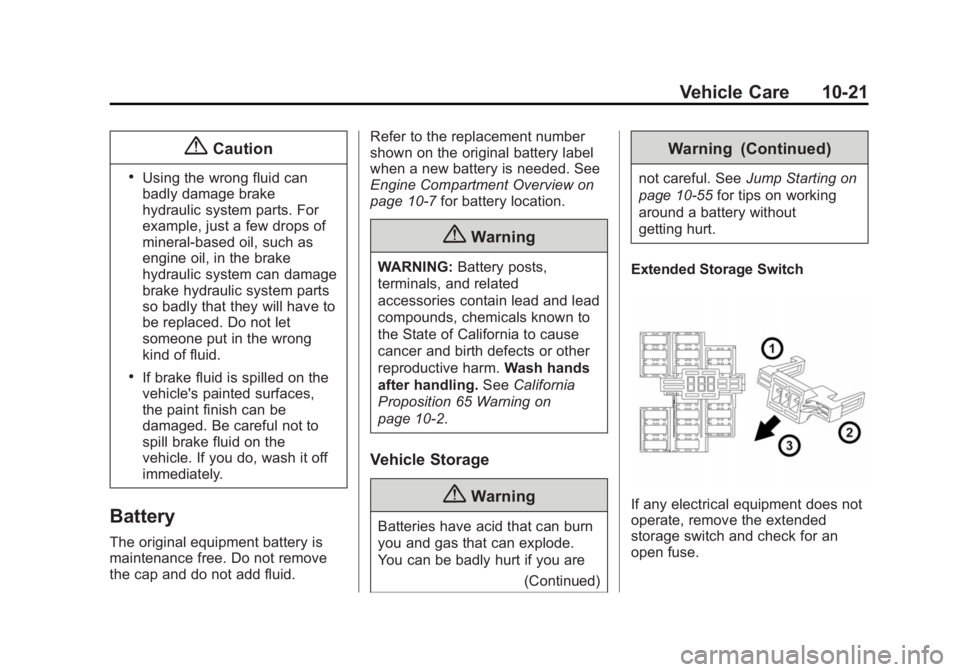
Black plate (21,1)Chevrolet City Express Owner Manual (GMNA-Localizing-U.S./Canada-
7707496) - 2015 - CRC - 11/26/14
Vehicle Care 10-21
{ Caution .
Using the wrong fluid can
badly damage brake
hydraulic system parts. For
example, just a few drops of
mineral-based oil, such as
engine oil, in the brake
hydraulic system can damage
brake hydraulic system parts
so badly that they will have to
be replaced. Do not let
someone put in the wrong
kind of fluid. .
If brake fluid is spilled on the
vehicle's painted surfaces,
the paint finish can be
damaged. Be careful not to
spill brake fluid on the
vehicle. If you do, wash it off
immediately.
Battery The original equipment battery is
maintenance free. Do not remove
the cap and do not add fluid. Refer to the replacement number
shown on the original battery label
when a new battery is needed. See
Engine Compartment Overview on
page 10-7 for battery location.
{ WarningWARNING: Battery posts,
terminals, and related
accessories contain lead and lead
compounds, chemicals known to
the State of California to cause
cancer and birth defects or other
reproductive harm. Wash hands
after handling. See California
Proposition 65 Warning on
page 10-2 .
Vehicle Storage
{ Warning
Batteries have acid that can burn
you and gas that can explode.
You can be badly hurt if you are
(Continued) Warning (Continued) not careful. See Jump Starting on
page 10-55 for tips on working
around a battery without
getting hurt.
Extended Storage Switch
If any electrical equipment does not
operate, remove the extended
storage switch and check for an
open fuse.
Page 208 of 297
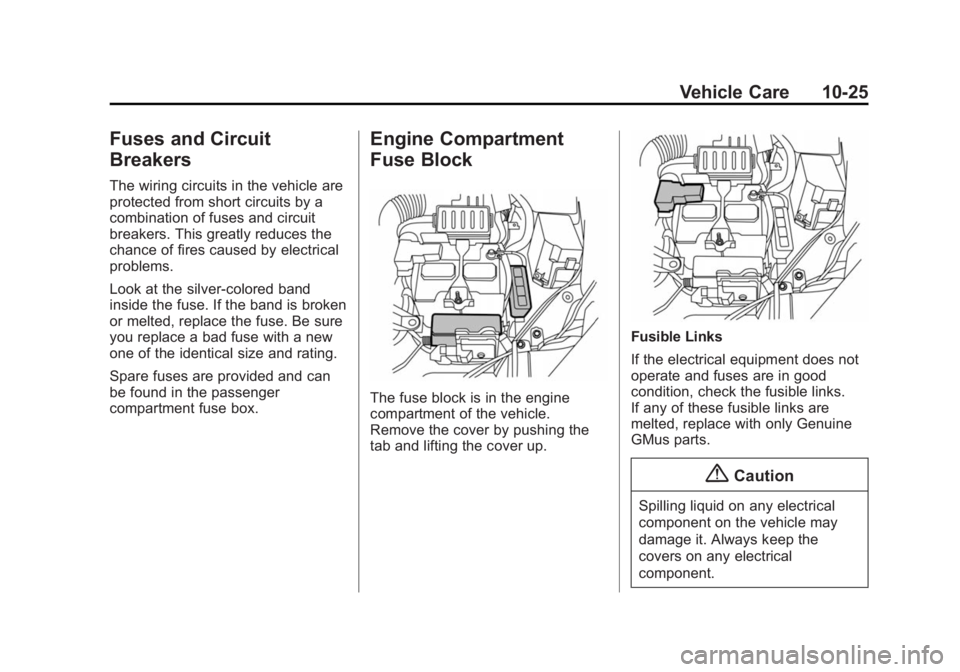
Black plate (25,1)Chevrolet City Express Owner Manual (GMNA-Localizing-U.S./Canada-
7707496) - 2015 - CRC - 11/26/14
Vehicle Care 10-25
Fuses and Circuit
Breakers The wiring circuits in the vehicle are
protected from short circuits by a
combination of fuses and circuit
breakers. This greatly reduces the
chance of fires caused by electrical
problems.
Look at the silver-colored band
inside the fuse. If the band is broken
or melted, replace the fuse. Be sure
you replace a bad fuse with a new
one of the identical size and rating.
Spare fuses are provided and can
be found in the passenger
compartment fuse box. Engine Compartment
Fuse Block
The fuse block is in the engine
compartment of the vehicle.
Remove the cover by pushing the
tab and lifting the cover up. Fusible Links
If the electrical equipment does not
operate and fuses are in good
condition, check the fusible links.
If any of these fusible links are
melted, replace with only Genuine
GMus parts.
{ Caution
Spilling liquid on any electrical
component on the vehicle may
damage it. Always keep the
covers on any electrical
component.
Page 241 of 297
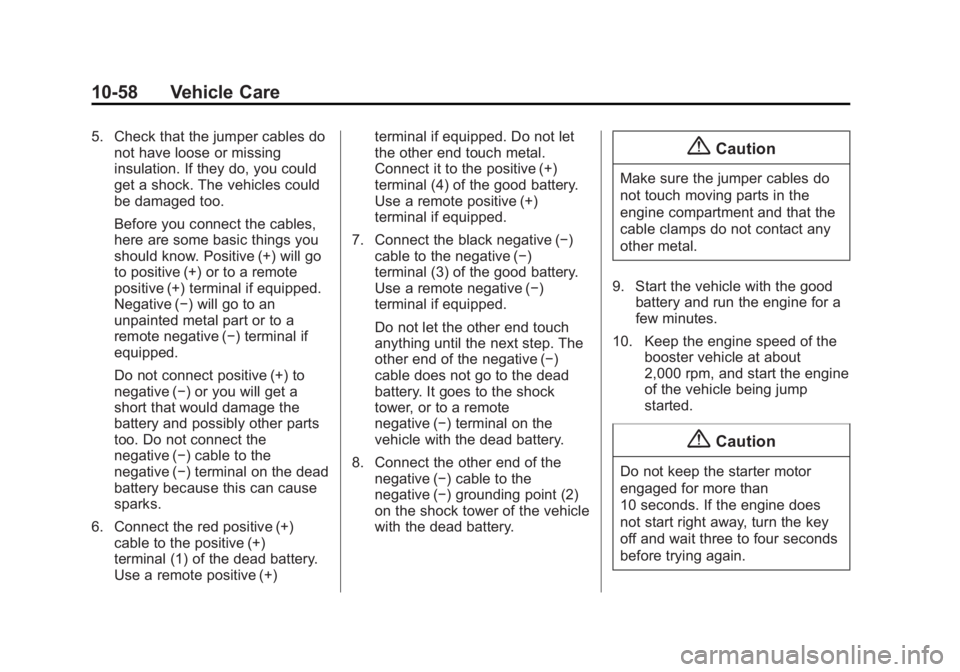
Black plate (58,1)Chevrolet City Express Owner Manual (GMNA-Localizing-U.S./Canada-
7707496) - 2015 - CRC - 11/26/14
10-58 Vehicle Care 5. Check that the jumper cables do
not have loose or missing
insulation. If they do, you could
get a shock. The vehicles could
be damaged too.
Before you connect the cables,
here are some basic things you
should know. Positive (+) will go
to positive (+) or to a remote
positive (+) terminal if equipped.
Negative ( − ) will go to an
unpainted metal part or to a
remote negative ( − ) terminal if
equipped.
Do not connect positive (+) to
negative ( − ) or you will get a
short that would damage the
battery and possibly other parts
too. Do not connect the
negative ( − ) cable to the
negative ( − ) terminal on the dead
battery because this can cause
sparks.
6. Connect the red positive (+)
cable to the positive (+)
terminal (1) of the dead battery.
Use a remote positive (+) terminal if equipped. Do not let
the other end touch metal.
Connect it to the positive (+)
terminal (4) of the good battery.
Use a remote positive (+)
terminal if equipped.
7. Connect the black negative ( − )
cable to the negative ( − )
terminal (3) of the good battery.
Use a remote negative ( − )
terminal if equipped.
Do not let the other end touch
anything until the next step. The
other end of the negative ( − )
cable does not go to the dead
battery. It goes to the shock
tower, or to a remote
negative ( − ) terminal on the
vehicle with the dead battery.
8. Connect the other end of the
negative ( − ) cable to the
negative ( − ) grounding point (2)
on the shock tower of the vehicle
with the dead battery. { CautionMake sure the jumper cables do
not touch moving parts in the
engine compartment and that the
cable clamps do not contact any
other metal.
9. Start the vehicle with the good
battery and run the engine for a
few minutes.
10. Keep the engine speed of the
booster vehicle at about
2,000 rpm, and start the engine
of the vehicle being jump
started.
{ Caution
Do not keep the starter motor
engaged for more than
10 seconds. If the engine does
not start right away, turn the key
off and wait three to four seconds
before trying again.
Page 256 of 297

Black plate (3,1)Chevrolet City Express Owner Manual (GMNA-Localizing-U.S./Canada-
7707496) - 2015 - CRC - 11/26/14
Service and Maintenance 11-3
Maintenance
Schedule Owner Checks and Services At Each Fuel Stop .
Check the engine oil level. See
Engine Oil on page 10-8 .
Once a Month .
Check the tire inflation
pressures. See Tire Pressure on
page 10-35 ..
Inspect the tires for wear. See
Tire Inspection on page 10-39 ..
Check the windshield washer
fluid level. See Washer Fluid on
page 10-18 . Oil Change, Tire Rotation, and
Required Services Every
8 000 km/5,000 mi Rotate the tires, if recommended for
the vehicle, and perform the
following services. See Tire
Rotation on page 10-39 . .
Change engine oil and filter. See
Engine Oil on page 10-8 . .
Check engine coolant level. See
Engine Coolant on page 10-13 ..
Check drive shaft boots. .
Check windshield washer fluid
level. See Washer Fluid on
page 10-18 . .
Visually inspect windshield wiper
blades for wear, cracking,
or contamination. See Exterior
Care on page 10-61 . Replace
worn or damaged wiper blades.
See Wiper Blade Replacement
on page 10-22 . .
Check tire inflation pressures.
See Tire Pressure on
page 10-35 . .
Inspect tire wear. See Tire
Inspection on page 10-39 . .
Visually check for fluid leaks. .
Inspect engine air cleaner filter.
See Engine Air Cleaner/Filter on
page 10-11 .
Page 258 of 297
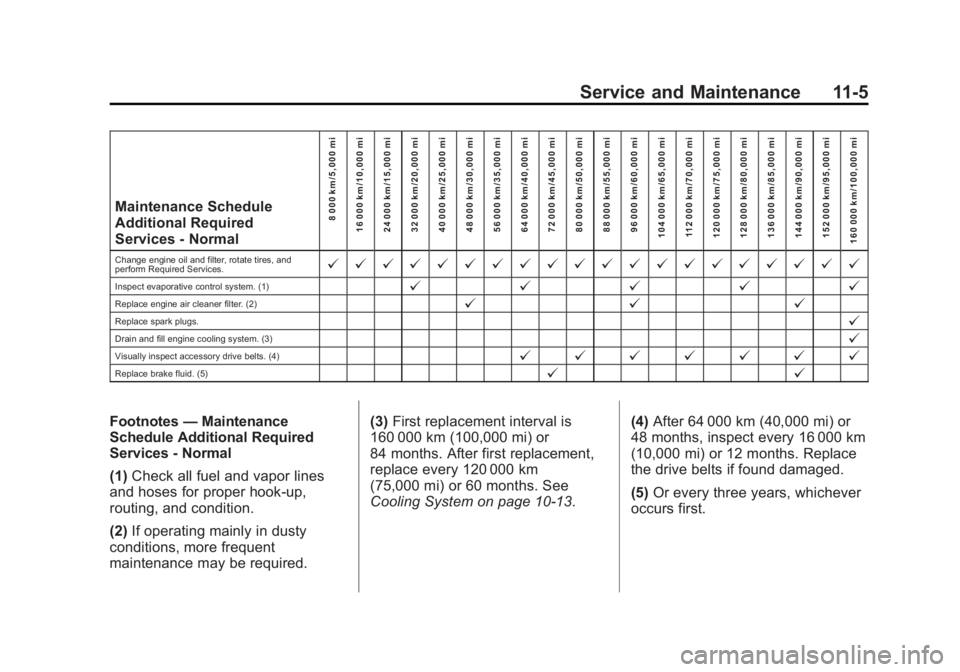
Black plate (5,1)Chevrolet City Express Owner Manual (GMNA-Localizing-U.S./Canada-
7707496) - 2015 - CRC - 11/26/14
Service and Maintenance 11-5Maintenance Schedule
Additional Required
Services - Normal
8 000 km/5,000 mi
16 000 km/10,000 mi
24 000 km/15,000 mi
32 000 km/20,000 mi
40 000 km/25,000 mi
48 000 km/30,000 mi
56 000 km/35,000 mi
64 000 km/40,000 mi
72 000 km/45,000 mi
80 000 km/50,000 mi
88 000 km/55,000 mi
96 000 km/60,000 mi
104 000 km/65,000 mi
112 000 km/70,000 mi
120 000 km/75,000 mi
128 000 km/80,000 mi
136 000 km/85,000 mi
144 000 km/90,000 mi
152 000 km/95,000 mi
160 000 km/100,000 miChange engine oil and filter, rotate tires, and
perform Required Services.
@ @ @ @ @ @ @ @ @ @ @ @ @ @ @ @ @ @ @ @Inspect evaporative control system. (1)
@ @ @ @ @Replace engine air cleaner filter. (2)
@ @ @Replace spark plugs.
@Drain and fill engine cooling system. (3)
@Visually inspect accessory drive belts. (4)
@ @ @ @ @ @ @Replace brake fluid. (5)
@ @
Footnotes — Maintenance
Schedule Additional Required
Services - Normal
(1) Check all fuel and vapor lines
and hoses for proper hook-up,
routing, and condition.
(2) If operating mainly in dusty
conditions, more frequent
maintenance may be required. (3) First replacement interval is
160 000 km (100,000 mi) or
84 months. After first replacement,
replace every 120 000 km
(75,000 mi) or 60 months. See
Cooling System on page 10-13 . (4) After 64 000 km (40,000 mi) or
48 months, inspect every 16 000 km
(10,000 mi) or 12 months. Replace
the drive belts if found damaged.
(5) Or every three years, whichever
occurs first.
Page 259 of 297
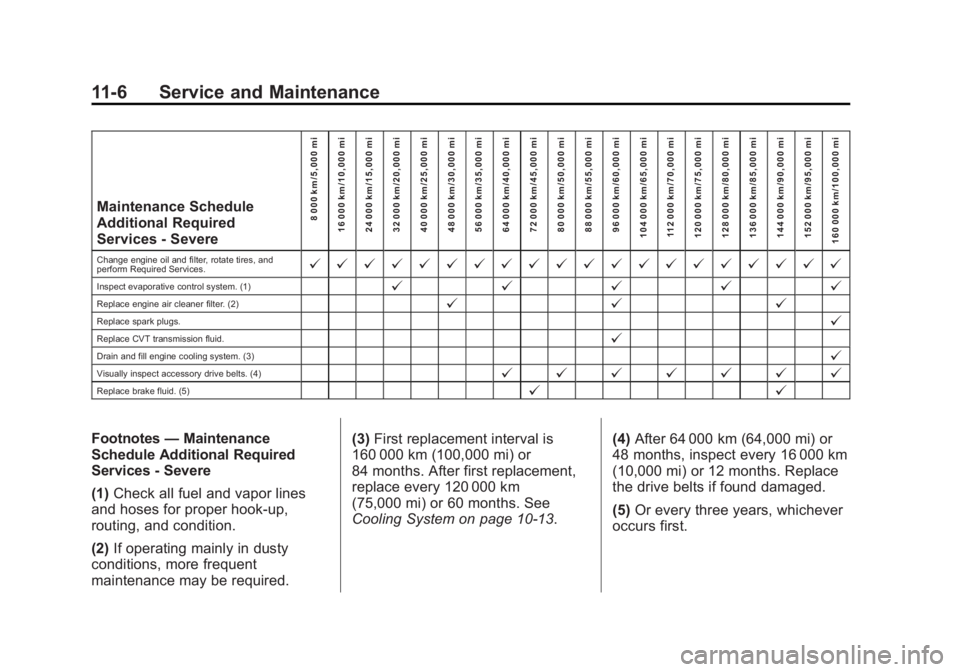
Black plate (6,1)Chevrolet City Express Owner Manual (GMNA-Localizing-U.S./Canada-
7707496) - 2015 - CRC - 11/26/14
11-6 Service and Maintenance Maintenance Schedule
Additional Required
Services - Severe
8 000 km/5,000 mi
16 000 km/10,000 mi
24 000 km/15,000 mi
32 000 km/20,000 mi
40 000 km/25,000 mi
48 000 km/30,000 mi
56 000 km/35,000 mi
64 000 km/40,000 mi
72 000 km/45,000 mi
80 000 km/50,000 mi
88 000 km/55,000 mi
96 000 km/60,000 mi
104 000 km/65,000 mi
112 000 km/70,000 mi
120 000 km/75,000 mi
128 000 km/80,000 mi
136 000 km/85,000 mi
144 000 km/90,000 mi
152 000 km/95,000 mi
160 000 km/100,000 miChange engine oil and filter, rotate tires, and
perform Required Services.
@ @ @ @ @ @ @ @ @ @ @ @ @ @ @ @ @ @ @ @Inspect evaporative control system. (1)
@ @ @ @ @Replace engine air cleaner filter. (2)
@ @ @Replace spark plugs.
@Replace CVT transmission fluid.
@Drain and fill engine cooling system. (3)
@Visually inspect accessory drive belts. (4)
@ @ @ @ @ @ @Replace brake fluid. (5)
@ @
Footnotes — Maintenance
Schedule Additional Required
Services - Severe
(1) Check all fuel and vapor lines
and hoses for proper hook-up,
routing, and condition.
(2) If operating mainly in dusty
conditions, more frequent
maintenance may be required. (3) First replacement interval is
160 000 km (100,000 mi) or
84 months. After first replacement,
replace every 120 000 km
(75,000 mi) or 60 months. See
Cooling System on page 10-13 . (4) After 64 000 km (64,000 mi) or
48 months, inspect every 16 000 km
(10,000 mi) or 12 months. Replace
the drive belts if found damaged.
(5) Or every three years, whichever
occurs first.
Page 261 of 297
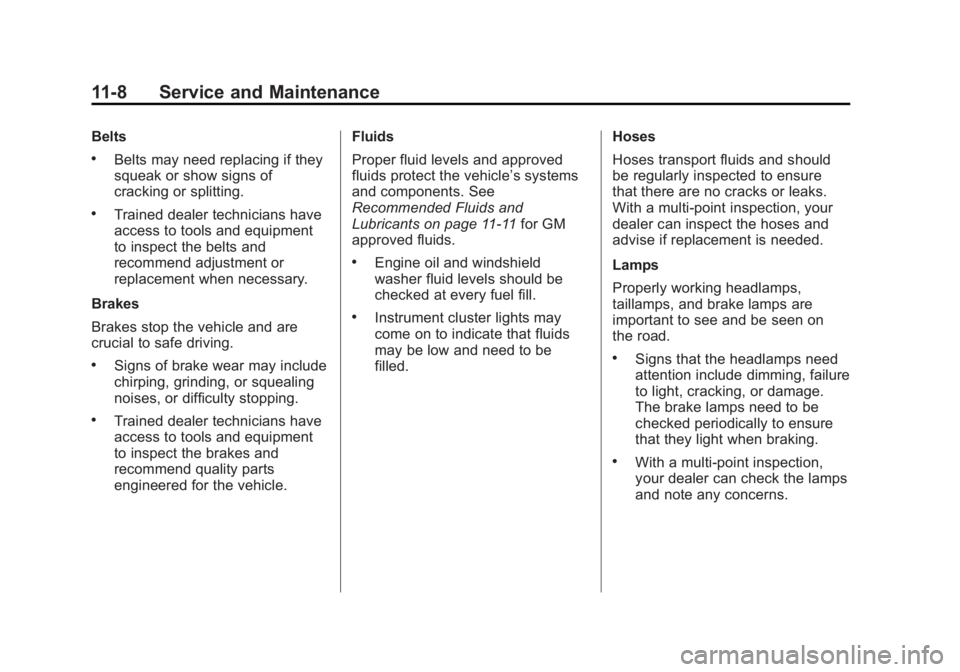
Black plate (8,1)Chevrolet City Express Owner Manual (GMNA-Localizing-U.S./Canada-
7707496) - 2015 - CRC - 11/26/14
11-8 Service and Maintenance Belts .
Belts may need replacing if they
squeak or show signs of
cracking or splitting. .
Trained dealer technicians have
access to tools and equipment
to inspect the belts and
recommend adjustment or
replacement when necessary.
Brakes
Brakes stop the vehicle and are
crucial to safe driving. .
Signs of brake wear may include
chirping, grinding, or squealing
noises, or difficulty stopping. .
Trained dealer technicians have
access to tools and equipment
to inspect the brakes and
recommend quality parts
engineered for the vehicle. Fluids
Proper fluid levels and approved
fluids protect the vehicle ’ s systems
and components. See
Recommended Fluids and
Lubricants on page 11-11 for GM
approved fluids. .
Engine oil and windshield
washer fluid levels should be
checked at every fuel fill. .
Instrument cluster lights may
come on to indicate that fluids
may be low and need to be
filled. Hoses
Hoses transport fluids and should
be regularly inspected to ensure
that there are no cracks or leaks.
With a multi-point inspection, your
dealer can inspect the hoses and
advise if replacement is needed.
Lamps
Properly working headlamps,
taillamps, and brake lamps are
important to see and be seen on
the road. .
Signs that the headlamps need
attention include dimming, failure
to light, cracking, or damage.
The brake lamps need to be
checked periodically to ensure
that they light when braking. .
With a multi-point inspection,
your dealer can check the lamps
and note any concerns.